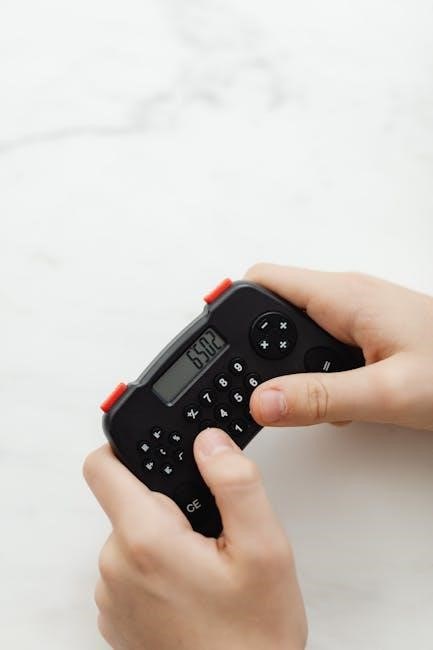
Honeywell Alarm Keypad Manual: A Comprehensive Guide
Welcome to your comprehensive guide to Honeywell alarm keypads. This manual is crafted to assist you in understanding, operating, and maintaining your Honeywell security system. We will delve into the functionalities and features to maximize your system’s effectiveness and security.

Understanding Honeywell Alarm Keypad Models

Honeywell offers a diverse range of keypad models, each designed with specific features and functionalities. Familiarizing yourself with your specific model is crucial for effective operation. Common models include the ADEMCO 6160, known for its alphanumeric display, and the 6150, featuring a fixed-English display. These keypads serve as the primary interface for controlling your Honeywell security system.
Understanding the nuances between models enables you to leverage their unique capabilities. Some models offer advanced features like voice status announcements, which can audibly communicate system status. Others may include built-in RF receivers for wireless device integration. Consulting your keypad’s specific manual is paramount to unlocking its full potential.
Furthermore, knowing your model helps in troubleshooting. Error messages and system prompts can vary slightly depending on the keypad. Accurate model identification ensures you’re referencing the correct documentation for resolving issues and customizing settings, ultimately optimizing your security system’s performance and reliability.
Keypad Features and Functions
Honeywell keypads boast a range of features designed for user-friendly interaction and comprehensive system control. Beyond basic arming and disarming, keypads offer functionalities such as zone bypassing, which allows you to temporarily disable specific sensors. Panic buttons provide immediate alarm activation in emergencies.
Many models feature alphanumeric displays, providing detailed system status messages and prompts. These displays aid in navigating the keypad menu for customization and troubleshooting. Some keypads also support voice annunciation, verbally communicating system status and alerts. Understanding these features is key to effectively managing your security system.
Furthermore, keypads often include programmable function keys, enabling quick access to frequently used commands. The backlit display ensures visibility in low-light conditions. Familiarizing yourself with each feature and its corresponding function enhances your ability to respond to various situations, ensuring optimal security and peace of mind. Regular practice with these functions is recommended.
Basic Operation: Arming and Disarming the System

The primary functions of your Honeywell alarm keypad are arming and disarming the system. Arming activates the sensors, providing protection against intrusion, while disarming deactivates them. To arm the system in “Away” mode, which activates all sensors, simply enter your user code followed by the “Away” key. Ensure all protected windows and doors are securely closed before arming.

For “Stay” mode, which arms the perimeter sensors while allowing movement inside, use the “Stay” key after entering your code. This is ideal for nighttime or when you’re at home. Disarming the system requires entering your user code followed by the “Off” key. A successful disarm will typically be indicated by a confirmation tone or message on the keypad display.
Familiarize yourself with the entry delay time, which allows you a grace period to disarm the system upon entering your home. Regular practice with arming and disarming ensures quick and confident operation in any situation, enhancing your security and reducing the risk of false alarms. Always remember your user code for seamless operation.
Navigating the Keypad Menu
The Honeywell keypad menu provides access to various system settings and functionalities. To enter the menu, typically you’ll need to press a designated key or combination of keys, such as the “Function” or “Menu” key, followed by your user code. The specific sequence can vary depending on your keypad model, so consult your specific manual for detailed instructions.
Once inside the menu, you can navigate using the arrow keys or number keys to scroll through options. Common menu items include zone settings, user management, system tests, and date/time adjustments. Selecting a menu item usually involves pressing the “Enter” or “*” key. Within each menu section, you can modify settings according to your preferences.
For example, in the user management section, you can add, delete, or modify user codes, granting different levels of access to various individuals. When making changes, it’s crucial to understand the implications of each setting. Always refer to your manual for explanations of each menu option. To exit the menu, press the “Exit” or “#” key. Regular exploration of the menu helps you personalize your system and ensures optimal performance.
Troubleshooting Common Issues
Experiencing issues with your Honeywell alarm keypad can be frustrating, but many problems have simple solutions. One common issue is a “Check” or “Trouble” light illuminating on the keypad. This usually indicates a system fault, such as a low battery, a communication problem, or a sensor malfunction. Start by consulting your system’s user manual to identify the specific error code displayed.
If the problem is a low battery, replacing the battery in the control panel or a wireless sensor might resolve the issue. For communication problems, ensure all connections are secure and that there are no obstructions interfering with wireless signals. If a zone is constantly triggering false alarms, inspect the corresponding sensor for damage or obstructions.
Another common problem is forgetting your user code. In this case, you may need to contact your alarm company for assistance in resetting the code. Avoid repeatedly entering incorrect codes, as this could lock the system. If the keypad is unresponsive, try power cycling the system by disconnecting the battery and AC power for a few minutes. Regularly testing your system and addressing issues promptly can prevent more significant problems.

Bypassing Zones

Bypassing a zone on your Honeywell alarm system allows you to temporarily disable a specific sensor without disarming the entire system; This is useful when a sensor is malfunctioning, such as a window sensor that triggers false alarms due to strong winds, or when you need to leave a window open while still arming the system. To bypass a zone, you typically need to enter your user code followed by the bypass command, often represented by the number “6” or a similar key.
Next, enter the two-digit zone number you wish to bypass. The keypad should display confirmation that the zone has been bypassed. Remember that bypassing a zone means it will not trigger an alarm if activated while the system is armed.
It’s crucial to understand the implications of bypassing zones and only do so when necessary. Always re-enable the zone as soon as the reason for bypassing it is resolved to ensure complete protection. Regularly review bypassed zones to avoid inadvertently leaving them disabled. Refer to your specific Honeywell keypad model’s manual for precise instructions and any variations in the bypassing procedure. Improper use of the bypass function can compromise your security.

Testing the Alarm System
Regularly testing your Honeywell alarm system is crucial to ensure it functions correctly and provides reliable protection. A system test verifies that all sensors are communicating with the control panel and that the alarm signal is properly transmitted to the monitoring center, if applicable. Before initiating a test, notify your monitoring center to avoid a false alarm dispatch. Inform them that you are conducting a system test and provide your account information.
To begin the test, consult your user manual for the specific test procedure for your Honeywell keypad model. Typically, this involves entering a test mode using a specific key sequence. Once in test mode, activate each sensor individually, such as opening doors and windows or triggering motion detectors. Observe the keypad display to confirm that each sensor is registering correctly. If any sensor fails to respond, troubleshoot the issue by checking the sensor’s battery, wiring, or placement.
After testing all sensors, end the test mode and contact the monitoring center again to confirm that they received the test signals. Consistent testing helps identify potential problems early, ensuring your system is always ready to protect your property.
Understanding Alarm Codes and Messages
Honeywell alarm keypads communicate system status and potential issues through a series of codes and messages displayed on the screen. Understanding these messages is vital for proper system operation and troubleshooting. Common messages include “Ready,” indicating the system is armed and ready to be armed; “Not Ready,” signifying that a zone is open or faulted, preventing arming; and “Alarm,” indicating an alarm event has been triggered.

Zone fault messages, such as “Zone 01 Fault,” pinpoint the specific sensor causing the problem, allowing for quick identification and resolution. Bypass messages confirm that a zone has been temporarily bypassed, meaning it will not trigger an alarm when armed. Trouble codes, often represented by numeric codes, signal system malfunctions like low battery, communication errors, or tamper alerts.
Consult your Honeywell keypad manual for a comprehensive list of alarm codes and messages specific to your model. This manual will provide detailed explanations of each message and recommended actions to resolve any issues. Familiarizing yourself with these messages empowers you to effectively manage your security system and respond appropriately to any alerts;

Programming and Customization (Advanced)
Advanced programming and customization options for your Honeywell alarm keypad allow you to tailor the system to your specific security needs. Accessing these features typically requires entering a master code or installer code, granting you control over system parameters. Zone settings, such as response times and sensor types, can be adjusted to optimize performance and prevent false alarms. User codes can be added, modified, or deleted, ensuring secure access for authorized individuals.
Communication settings, including phone numbers for central station monitoring, can be configured to maintain reliable alarm reporting. Event logs, which record system activity, can be reviewed to track arming/disarming events, alarm triggers, and user activity; Advanced features may include automating system functions based on schedules or events.
Customization options vary depending on your Honeywell keypad model. Consulting the advanced programming section of your specific manual is essential before making any changes. Incorrect settings can compromise your system’s security, so proceed with caution and consider seeking professional assistance if needed. Properly programmed and customized, your Honeywell system provides a robust and personalized security solution.
Maintaining Your Honeywell Keypad
Proper maintenance ensures the longevity and reliability of your Honeywell keypad. Regularly inspect the keypad for physical damage, such as cracks or loose buttons. Clean the keypad surface with a soft, dry cloth to remove dust and fingerprints, avoiding harsh chemicals or abrasive cleaners. Batteries, if applicable, should be replaced periodically to prevent power failures. Check the battery status indicator on the keypad and replace batteries when prompted.
Test the keypad functionality regularly by arming and disarming the system, triggering alarms, and verifying that all buttons and indicators are working correctly. Review the system event log to identify any unusual activity or errors. Keep the keypad area free from obstructions that could interfere with sensor operation or keypad access. Ensure that the keypad is securely mounted to prevent tampering or accidental damage.
If you encounter any persistent issues or malfunctions, consult the troubleshooting section of your Honeywell keypad manual or contact a qualified technician for assistance. Regular maintenance, combined with prompt attention to any problems, will help to keep your Honeywell keypad functioning optimally, ensuring your security system remains effective and reliable for years to come.
Finding the Right Manual for Your Model
Locating the correct manual for your specific Honeywell keypad model is crucial for understanding its features and functions. Start by identifying the model number, typically found on a sticker on the back or inside the keypad. Once you have the model number, visit the Honeywell Security website or a reputable online retailer that sells Honeywell products. Look for the “Support” or “Downloads” section, where you can enter the model number to find the corresponding manual.
Alternatively, search online using the model number along with keywords like “user manual” or “installation guide.” If you have the original system documentation, the manual may be included. If you are still unable to locate the manual, contact Honeywell’s customer support or a local security system installer. They can often provide a digital copy or direct you to the appropriate resource.
Remember that using the correct manual ensures you have accurate information about your keypad’s specific features and programming options. This is essential for proper operation and troubleshooting. Using the wrong manual can lead to confusion and potentially compromise the security of your system.
